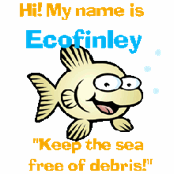Pup loses struggle to survive
Feb/13/11 04:21 PM
Yesterday around noon Seal Sitters responded to the report of a pup on a private beach. The beach was inaccessible to the public except at low tide when many people walk with their dogs along the water’s edge. It is for this reason that we established a tape barrier at the northwest end of Constellation Park, despite sustained high winds and waves. Thankfully, at low tide a drenching rain squall moved in over West Seattle which deterred even the most hardy of wave watchers. Our volunteer checked as late as 8:37 pm and the very thin pup had not yet returned to the water. Earlier in the day arrangements had been made to take the pup to PAWS this morning if he was still on the beach. Sadly, our responders found the little one dead at approximately 6:30 am. It is NOAA policy that if a pup is coming and going from the beach, there is to be no intervention. One never wants to remove a viable animal from the wild. Capture and transport can be terribly stressful on a seal pup, often escalating health issues, and is only done as a last resort.
Photo comparison of markings had determined yesterday evening that this was the same pup we watched over on Wednesday at Luna Park. It was evident that afternoon that the pup had some health issues, though it could not be determined how serious. However, to our volunteers’ relief, the pup (nicknamed Babe because she was so tiny and precious) returned to Elliott Bay when the tide came in. It is always an encouraging sign when a pup returns to the water to forage for food.
As we have stated many times, seal pups only have a 50% survival rate for the first year. It is critical that all of these pups be given the space to rest undisturbed so that they can conserve their very few expendable calories. It takes every bit of strength for them to survive in what seems too often like a very harsh world. Thanks to all the waterfront residents who were so concerned and cooperative in efforts to help this pup. A necropsy will be performed by WDFW Marine Mammal Investigations Unit to determine cause of death.
UPDATE 2/20/11:
The necropsy results have revealed that this very thin female pup was managing to forage (with 20 squid beaks in her stomach and fish bones in the feces). However, the blubber layer was terribly inadequate. There was evidence of some heartworms and lungworms, the parasite load was not significant. Tissue samples were sent out for tests for bacteria and viral load, but those results will not be returned for some time. As the marine mammal biologist who performed the necropsy told us, often low body weight alone is enough to tip them just past the edge of survival.
Photo comparison of markings had determined yesterday evening that this was the same pup we watched over on Wednesday at Luna Park. It was evident that afternoon that the pup had some health issues, though it could not be determined how serious. However, to our volunteers’ relief, the pup (nicknamed Babe because she was so tiny and precious) returned to Elliott Bay when the tide came in. It is always an encouraging sign when a pup returns to the water to forage for food.
As we have stated many times, seal pups only have a 50% survival rate for the first year. It is critical that all of these pups be given the space to rest undisturbed so that they can conserve their very few expendable calories. It takes every bit of strength for them to survive in what seems too often like a very harsh world. Thanks to all the waterfront residents who were so concerned and cooperative in efforts to help this pup. A necropsy will be performed by WDFW Marine Mammal Investigations Unit to determine cause of death.
UPDATE 2/20/11:
The necropsy results have revealed that this very thin female pup was managing to forage (with 20 squid beaks in her stomach and fish bones in the feces). However, the blubber layer was terribly inadequate. There was evidence of some heartworms and lungworms, the parasite load was not significant. Tissue samples were sent out for tests for bacteria and viral load, but those results will not be returned for some time. As the marine mammal biologist who performed the necropsy told us, often low body weight alone is enough to tip them just past the edge of survival.







